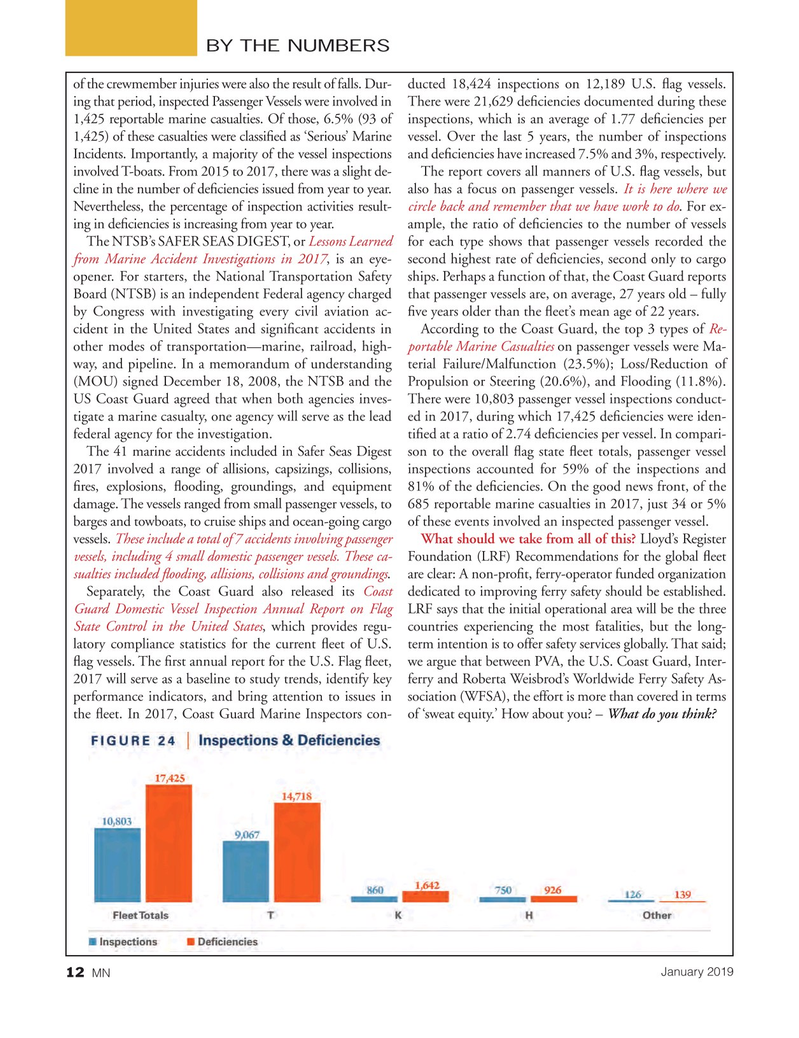
Page 12: of Marine News Magazine (January 2019)
Passenger Vessels & Ferries
Read this page in Pdf, Flash or Html5 edition of January 2019 Marine News Magazine
BY THE NUMBERS of the crewmember injuries were also the result of falls. Dur- ducted 18,424 inspections on 12,189 U.S. ? ag vessels. ing that period, inspected Passenger Vessels were involved in There were 21,629 de? ciencies documented during these 1,425 reportable marine casualties. Of those, 6.5% (93 of inspections, which is an average of 1.77 de? ciencies per 1,425) of these casualties were classi? ed as ‘Serious’ Marine vessel. Over the last 5 years, the number of inspections
Incidents. Importantly, a majority of the vessel inspections and de? ciencies have increased 7.5% and 3%, respectively.
involved T-boats. From 2015 to 2017, there was a slight de- The report covers all manners of U.S. ? ag vessels, but cline in the number of de? ciencies issued from year to year. also has a focus on passenger vessels. It is here where we
Nevertheless, the percentage of inspection activities result- circle back and remember that we have work to do. For ex- ing in de? ciencies is increasing from year to year. ample, the ratio of de? ciencies to the number of vessels
The NTSB’s SAFER SEAS DIGEST, or Lessons Learned for each type shows that passenger vessels recorded the from Marine Accident Investigations in 2017, is an eye- second highest rate of de? ciencies, second only to cargo opener. For starters, the National Transportation Safety ships. Perhaps a function of that, the Coast Guard reports
Board (NTSB) is an independent Federal agency charged that passenger vessels are, on average, 27 years old – fully by Congress with investigating every civil aviation ac- ? ve years older than the ? eet’s mean age of 22 years.
cident in the United States and signi? cant accidents in According to the Coast Guard, the top 3 types of Re- other modes of transportation—marine, railroad, high- portable Marine Casualties on passenger vessels were Ma- way, and pipeline. In a memorandum of understanding terial Failure/Malfunction (23.5%); Loss/Reduction of (MOU) signed December 18, 2008, the NTSB and the Propulsion or Steering (20.6%), and Flooding (11.8%).
US Coast Guard agreed that when both agencies inves- There were 10,803 passenger vessel inspections conduct- tigate a marine casualty, one agency will serve as the lead ed in 2017, during which 17,425 de? ciencies were iden- federal agency for the investigation. ti? ed at a ratio of 2.74 de? ciencies per vessel. In compari-
The 41 marine accidents included in Safer Seas Digest son to the overall ? ag state ? eet totals, passenger vessel 2017 involved a range of allisions, capsizings, collisions, inspections accounted for 59% of the inspections and ? res, explosions, ? ooding, groundings, and equipment 81% of the de? ciencies. On the good news front, of the damage. The vessels ranged from small passenger vessels, to 685 reportable marine casualties in 2017, just 34 or 5% barges and towboats, to cruise ships and ocean-going cargo of these events involved an inspected passenger vessel. vessels. These include a total of 7 accidents involving passenger What should we take from all of this? Lloyd’s Register vessels, including 4 small domestic passenger vessels. These ca- Foundation (LRF) Recommendations for the global ? eet sualties included ? ooding, allisions, collisions and groundings. are clear: A non-pro? t, ferry-operator funded organization
Separately, the Coast Guard also released its Coast dedicated to improving ferry safety should be established.
Guard Domestic Vessel Inspection Annual Report on Flag LRF says that the initial operational area will be the three
State Control in the United States, which provides regu- countries experiencing the most fatalities, but the long- latory compliance statistics for the current ? eet of U.S. term intention is to offer safety services globally. That said; ? ag vessels. The ? rst annual report for the U.S. Flag ? eet, we argue that between PVA, the U.S. Coast Guard, Inter- 2017 will serve as a baseline to study trends, identify key ferry and Roberta Weisbrod’s Worldwide Ferry Safety As- performance indicators, and bring attention to issues in sociation (WFSA), the effort is more than covered in terms the ? eet. In 2017, Coast Guard Marine Inspectors con- of ‘sweat equity.’ How about you? – What do you think?
January 2019 12 MN
MN Jan19 Layout 1-17.indd 12 MN Jan19 Layout 1-17.indd 12 1/9/2019 12:02:37 PM1/9/2019 12:02:37 PM

 11
11

 13
13
